#I should also just draw him in his TOA design since I like it
Text

Oh yeah so I drew this yesterday, I just forgot to post it here
So it’s supposed to be Dark Choco in this outfit seen in Tower of Adventures

I mean it’s literally called the Royal Cacao Coat, I had to draw one of the two in it
To be honest, the drawing isn’t the best. I really didn’t know what to do for the pose. Or the expression really
I made a different pose originally that I didn’t really like and wanted to change, and during dinner I had some other idea that I wanted to use, but by the time I was finished, I had forgotten what it was and basically ended up making the same pose again, just bigger
I’m also not sure what expression I wanted him to have. He has one, but I don’t know what it’s supposed to be or why. I guess it’s unease about wearing something from his old kingdom again, but I don’t really know
I also didn’t really know what to put under the coat, since the thing I’m given is just that coat, so I just put something random. I’m realizing I probably could have had it closed up, there’s no reason it couldn’t be, but whatever
Honestly I’d rather take another shot at drawing him in this outfit, but for now at least I might as well post what I got already
#hopefully someone else at least will draw him or his dad in the outfit#also the outfit was a bit more complicated than I was expecting#or I was just having a hard time with it#I should also just draw him in his TOA design since I like it#cookie run#cookie run tower of adventures#dark choco cookie#my art
74 notes
·
View notes
Text
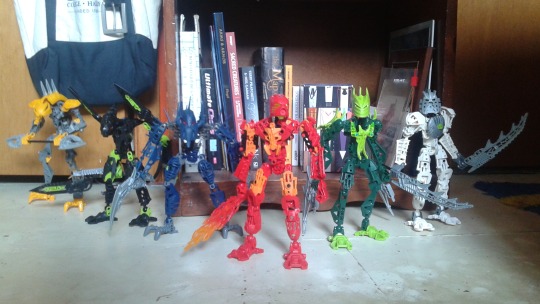
Happy FUCKING 810NICLE Day, y'all! I've got a lot of stuff I want to post today, so I'm getting started at the end. Have some Stars revamps. Or, total redesigns, really. Built from scratch in a set-plausible design intended to stick as closely to their original looks as possible while still fitting into the scale and aesthetics of Bionicle's later years.
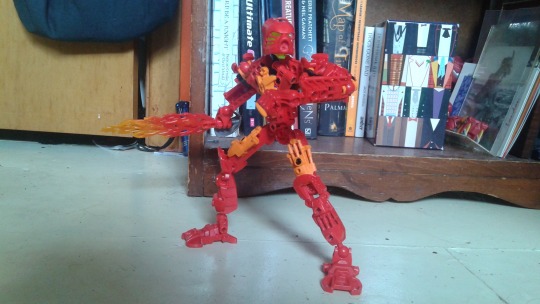
Tahu was designed as a hybrid between his original Toa Mata appearance and the aesthetics of the Adaptive Nuva. He's an Inika build, representing that the Adaptive Armour is (partially) active, but has the slimmer silhouette of his Mata days (Plus a back gear, if you can believe it. It's not visible in any of these pictures, but it's there. Doesn't do anything, but it's a fun little decoration). I wish I could have given him fully orange limbs to match the set better, but the red hardly looks bad. I'm particularly proud of how I managed to incorporate the Stars armour pieces on the larger build, especially since it means I can do...

...this. All six of the original Golden Armour pieces still fit perfectly onto this Tahu, though I've taken the liberty of swapping out the shield for a bigger, more practical piece. He's very shiny.

Gresh has slimmed down a lot since his days as a Glatorian. In-story, I imagine this would be a result of ditching the ornamental, overly showy armour worn by most Glatorian in favour of lighter, more effective combat gear that compliments his new Air powers. Like Tahu, I was able to carry over his Stars set armour, though not quite as elegantly. He's a bit of a stick figure, but I still love him, especially since he's the only one of the six whose colour layout is basically exactly the same as his official set, part for part, with the exception of a black neck.
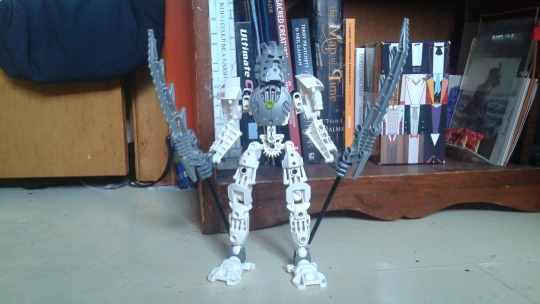
2010 Takanuva is supposed to be the Toa of Light in his normal form, just with his colours altered to camouflage himself as a Toa of Ice to avoid drawing attention to himself. So, here he is scaled up into a Metru build to keep him at the proper size. I didn't feel like painting anything here, so his torso's colours are off, but I can't say I care that much. He also has a working gear function, sooo...bonus!
Also, I don't know about anyone else, but I always thought it was ridiculous that Takanuva would discard his Power Lance, an amazing tool that not only channeled his powers, but also amplified them, in favour of the Twin Light Staffs, which do nothing of note except exist as a pair. So, have this headcanon: At some point during the reign of Teridax, Takanuva's Power Lance was broken. Unwilling to surrender the advantage the tool gave him, Takanuva fashioned the broken pieces of the lance into the Twin Light Staffs, specifically opting for two as a nod to the twin Power Swords traditionally wielded by Av-Matoran. Thus is the thought process for using Air Sabers as the heads of his staffs in this revamp.
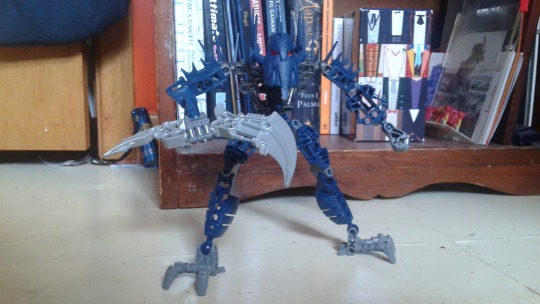
Nektann is a Piraka build. And that's about it. I kept his hands, feer, and weapon from his set form, and slapped 'em on a basic Skakdi body. Took a bit of work to get his head on, but nothing too wild. After that, it was just a matter of attaching his spines to his back and arms and he was done. Technically, Nektann is supposed to be larger than the average Skakdi, but I haven't figured out a way to make that look good as of yet, so this is all I've got for him, for now.
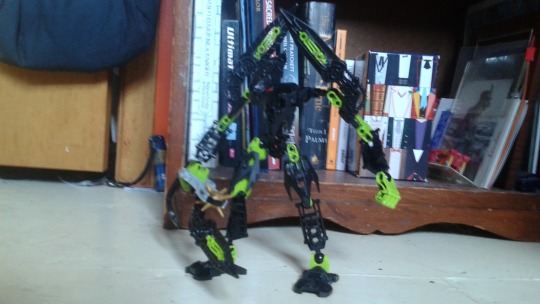
Also, in the realm of revamps that are just tweaks to existing sets, have Winter 2009's Skrall, now in lime green and without a shield. New feet though! Yeah, this one isn't terribly creative on my part, but it is what the figure should look like, canonically speaking, and that's what I was going for, so I'm satisfied.
At least this guy gets the satisfaction of being the only one of the bunch with a launcher.

And finally, the Rahkshi of Heat Vision, alternatively and unofficially known as Zirahk. The Rahkshi design, oddly enough, was not difficult to translate into Inika scale at all, thanks to the pieces of the Stars set. The neck plugs into the front of an Inika torso with ease and the spine attaches to the back just as easily. There's even enough room to wedge a little Kraata of Heat Vision in there. I'm still amazed I have one of those. Anyway, the big challenge here was the size. Did you know Rahkshi are supposed to be 9 FEET TALL?? Because I found that out only recently. Naturally, a stubby little Rahkshi was't gonna cut it, I had to make this lad TOL.
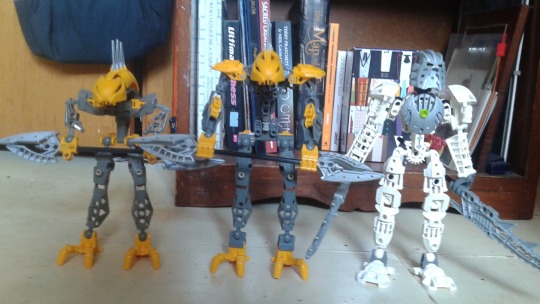
And as you can see, it's still too small! As is, Zirahk is taller than an average Inika build; not quite as much as it should be, but it's as good as it's gonna get, methinks.
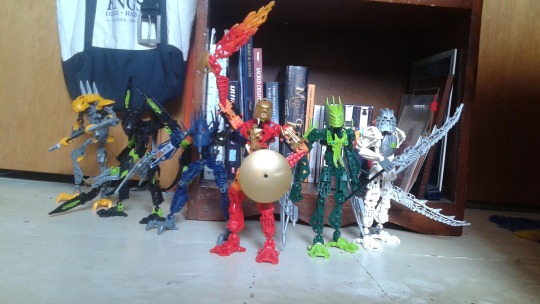
And to close, another group shot. Once again, happy 810 everybody. More to come.
95 notes
·
View notes
Text
Tales of Zestiria - Post Game Thoughts
(Or, I Ramble For Far Too Long About My Feelings And Theories Concerning This Beautiful Game)
Topics:
Introduction
Gameplay (graphics, systems, all that technical jazz)
Plot
Sidequests
Characters
Character Relationships
Music
Other Media (Anime, Manga, Novel)
In Conclusion
Introduction
Last night, I finally sat down and defeated the final boss in Tales of Zestiria. Needless to say, I had a lot of thoughts after witnessing the ending. Even after having written this monster of a post, I still have thoughts which have gone unwritten. This is just a few of the things I have to say about this game.
For a quick general review, though: 4.5/5 stars. A great story (albeit slightly rushed) with amazing characters and a beautiful gameplay and soundtrack. Even if you’re new to the Tales Of series, I’d recommend you to play this game.
Now, onto the meat of this post. I’ve tried to avoid spoilers as much as possible, and I’ve marked where I talk explicitly about spoilerific subjects. Still, be on your guard a bit.
Gameplay
Right off the bat, this game is beautiful. Having come from playing Tales of Vesperia (a 2007 game with good graphics which are nothing in comparison to TOZ) and Tales of the Abyss (which I’m still in progress with and switching between TOZ and TOA is always pretty jarring), I could not help but marvel at the graphics at every point during the game. The 3DCG animation is fluid and natural – in conversation, the characters have quirks which make them seem more realistic, something which I felt the aforementioned games lacked (not for lack of trying). The 2D anime cutscenes were also stunning, though I felt some were not particularly memorable.
The overall aesthetic of the game is also gorgeous – something I feel the Tales of series does particularly well in general. The character designs are gorgeous, especially for the main cast (though I feel this is a given). The towns are beautiful. Some of the scenery is downright stunning. I’m not an artist or designer, so unfortunately I’m not to grips with technical terminology or criticism, but that doesn’t stop me from drawing breath every time something caught my eye.
The system itself I found mostly easy to understand. The menu is akin to the other Tales games I’ve played, and I found map actions easy enough to understand. (My immediate reaction was that it was similar to the Sorcerer’s Ring in TOV, for a while.) I sometimes found having a secondary character running after me a bit annoying (Rose, this corridor is tiny and you’re blocking the door, please move- oh, fuck, a hellion). For the most part though, being able to speak to the secondary character and get hints about both the main story and sidequests was a godsend.
The battle system, though different from those in TOV and TOA, was in my opinion improved on in this game. I enjoyed having different kinds of artes to play around with, though telling the difference between the three was sometimes tedious. I also liked how easy it was to switch between melee attacks and hidden artes. Also backstepping and sidestepping became so useful in boss battles, particularly towards the end once I got to grips with it.
What I found more tedious was the skills system – I’m sure it will be less so once I get to grips with it, but having a skill tree with different combination options is something that might take me a while to wrap my head around. I also still haven’t ventured near the ‘forge arms’ option in stores, because I’ve heard that’s to do with skills and honestly I still don’t understand them enough to want to do that yet.
Though I do appreciate the ways in which the game gives you tutorials – not through a tedious tutorial battle, like in TOV, but through monoliths (which were fun to find and read, even if I wouldn’t normally have bothered reading the contents of them) and skits (which at least tried to make them sound interesting).
I also appreciated the game’s switching between battles and puzzles for dungeons. It really instilled a sense of, the answer to everything isn’t just beating it up, even when I used Edna’s map action (which seemed like beating up walls and rocks). And though some of the puzzles might have been a little tedious (*cough* water shrine *cough*), once I figured out how to get around the puzzles, it became really interesting to me. Yes, even for the water shrine.
(On that note, is it just me or was the wind shrine really easy? Like, easier than the others, I mean.)
Plot
The plot of Zestiria, in my opinion, was mostly well done. It follows the journey of Sorey and his friends as he becomes the Shepherd and fights in order to free the world from malevolence, with a focus on defeating Heldalf, the Lord of Calamity.
*** The following paragraph contains massive spoilers. ***
To be completely honest, the plot did feel a little rushed, at times. Even when I got to the final dungeon, I had to check it was definitely the final battle, because it felt like there should have been more. After all, we didn’t get so much resolution on Maotelus’ history or future (though I suppose much of it was up to interpretation). I also kept thinking that there had to be another way of ending it all, especially since in the beginning, Sorey resolved within the main plot to help Edna to purify her brother, but that isn’t addressed in the main plot at all after that point.
In the end, though I had wanted a different ending, I understand that this might be reflection of what the story is trying to tell us. Not all endings are peaches and cream happy fun times. Something has to be sacrificed in order to gain a good outcome, and not all people – humans or seraphim – necessarily believe that what the Shepherd is doing is for the best. (For that reason, Symmone’s story was really interesting for me, though she had more potential than what was utilised.)
So after some consideration, I feel that they ended the game in the best way they could have done for the story that it’s trying to tell. Even if it wasn’t the most positive and happy-ending kind of story, there still is a positive in the future.
(Again, I feel that’s something the Tales games do well – illustrating the multiple facets of a situation, how any solution has consequences, both good and bad. Not everyone will agree, and not everything will be solved, but when the root of the problem has been fixed, that is where the story ends for us, even if it goes on for them.)
*** Spoilers end here. ***
Some points of the plot also felt rather tedious – purify the malevolence here, find the iris gems there, go to and from Glaivend Basin about ten different times. Still, the story behind the plot is strong enough to make an interesting game. It has certainly made me interested in the lore behind the Shepherd and the history of that world as well as the future of it.
(On that note, is Glenwood the only continent mentioned in the game, or is it just me? How do you save the world by travelling over one continent? Are you just saving that continent from malevolence?)
Sidequests
Despite the fact that I’m glad so much of the story was told through the main plot, I feel that sidequests were somewhat lacking. I think it’s because I’m so used to Tales of Vesperia, which has a gazillion sidequests (which I’m almost finished completely! The fact that it’s taken me five years to get close to 100% completion is definitely saying something). Since this was only my first playthrough, I haven’t thought much about the sidequests. I’ll come back to this when I’ve done more of them.
(Sidenote: The turtlez sidequest made my entire life.)
Characters
Sorey
Sorey, my boy. My sunshine child. Can I just wrap him up and protect him from the world?
I love Sorey so much (if you couldn’t already tell). He’s an innocent, sheltered boy, having lived in the remote Elysia alongside seraphim for all his life. And yet he is filled with a passion and charisma and general optimism, especially when it comes to things like ruins (I love his history nerd side so much, but maybe that’s because I’m interested in history too). He has a definite hero complex (and perhaps a martyr complex?) which feels like a main part of the plot – the fact that he wants to save everyone, to see everyone living in peace and harmony together, and the fact that in this world filled with malevolence, it seems unlikely to ever happen.
Some people might feel that Sorey is too vanilla for them, considering his hero complex and naivety, but in my opinion there is a lot more depth to his character when you consider the hardships he has to go through, particularly towards the end of the game.
Mikleo
I loved this boy even before I played the game. I knew nothing of his character, but his general aesthetic pleased me greatly. The game did not disappoint. Mikleo is a stubborn but kind seraph, one who relies heavily on logic and analysis to think through situations. For that reason, he loves ruins just as much as Sorey, particularly trying to analyse them and to see how things work and what the reasons for certain things might be. (I’m not kidding, a skit about matryoshka dolls is what triggered me to find this interesting.)
His character depth and development is beautiful, especially when you consider his fears in the beginning of the game (not wanting to be a burden to Sorey, but not wanting to be left behind, with the knowledge that he will age much more slowly than Sorey and will certainly end up outliving him). Though he is still a bit of a kid (that much is obvious in how he rises up to Edna’s teasing), he is still rather mature and eloquent.
Alisha
I can see where the controversy comes from, surrounding Alisha. The advertising for the game made it seem as though she was the main female character assisting Sorey, but she ends up leaving the party for the majority of the game. Still, I think Alisha was a well-written character and an interesting contrast to her successor, Rose.
Alisha is a strong-hearted, optimistic girl who wants to serve her kingdom in whatever way she can. Like Sorey, she believes in the Shepherd and the seraphim and wants to see the world rid of malevolence. The only trouble is that Alisha’s resonance, whilst stronger than most humans’, is still not quite up to par, making it difficult for her to assist Sorey as his Squire.
In my opinion, I felt this was an interesting character flaw. It gave depth both to her and to Sorey, considering the effects of it on the both of them as time goes on. Even though many might have been disappointed that she could not armatize in-game due to her lack of resonance, I felt it befitting of her character.
I’ve not played her DLC yet, but I still enjoy her character very much and think her development throughout the game was strongly written, even if it was mostly in the background.
Lailah
I love Lailah so much. As the guardian type of character, she has the most knowledge – and yet, she cannot pass on much of it due to an oath restricting her from it. This, I feel, is a huge part of what makes one of the main plot themes, ‘finding the answers’. (I’ll talk about that later, though.)
Lailah is a cheerful but conscientious character. She has experienced being a Prime Lord for a Shepherd before, and knows about the truth behind the Dawn of the Age of Chaos. Her inability to speak about it makes her rather mysterious (though I enjoy her whimsical methods of avoiding the subject). Outside of her role as a Prime Lord, Lailah is a humorous and almost motherly character (though she’d rather you call her ‘big sister’, thanks). She cracks puns and jokes quite often, much to the chagrin of her friends.
I also enjoy the development she goes through and her subtle way of realising that she doesn’t have to carry her burden all on her own, either. (The Lailah and Rose conversation before the final battle makes this all the more poignant, in my opinion.)
Edna
I will fight for Edna. I love Edna. Protect Edna 2K17.
Seriously, though, Edna is wonderful. She is a sassy, sarcastic character with a troubled past and present (particularly familial). She enjoys poking fun at the more gullible characters, particularly Mikleo (or Meebo, as she calls him).
Her development is also beautifully done, particularly in the sidequest concerning the dragon at Rayfalke Spiritcrest. Though she is reluctant at the beginning of the game, we see her opening up to her companions and fighting alongside them for their cause. I might have liked to see more development for her in the main plot, though I feel the sidequests did her justice enough.
Rose
I love Rose.
By day, she’s a cheerful merchant, always shaking the hand of capitalism in search of a deal. By night, she becomes an assassin, gracing weary bones with peaceful rest. And her dual personality is only the top layer of her character – it doesn’t even scrape the surface of her past.
(This is something I feel particularly in regards to the anime, though I’ll speak about that later.)
I love that Rose acts as Sorey’s foil – the dark to his light, in a sense, though they fight for the same cause and are both of pure heart. She is just as selfless and forgiving as he is, though her way of solving problems is different from Sorey’s. (Is anyone else getting flashbacks to Flynn and Yuri? One seeks justice through what is morally right, the other through murder…)
Her reluctance to accept the existence of seraphim also intrigued me and gave her role as Sorey’s second squire an interesting twist. I also love how she develops, eventually accepting and embracing the seraphim, and being grateful for their presence around her.
Dezel
(Brb, currently weeping softly.)
Dezel grated on me a bit at first, mostly because of how he acts when we first meet him. And to be honest, for most of his role in the game, he is the same way, though obviously he does have some development which helps towards his major change of thinking in his final scene. His backstory greatly intrigued me and through it, you can certainly tell that he is only young, and hence gets easily riled up. Any mention/indication of him after That One Scene made me want to cry. His redemption truly was well done. I would have liked to see more of him.
Zaveid
This man needs to be stopped. Stop Zaveid 2K17.
(I’m joking, but still.)
I love Zaveid. He reminds me a lot of TOV’s Raven – kind of a comic relief in his commentaries, particularly concerning ladyfolk, but with a depth of character hidden behind that mask. I did feel that his entrance to the party was a little rushed (they could have given us a little time to grieve, dammit), but other than that I enjoyed playing as him. I feel like his development was a little less obvious because of the façade he keeps up, as well as his status as a semi-antagonist in the beginning, but in general, he was well written and interesting.
Character Relationships
In general, I love the relationships between the characters. I love that the game places no emphasis on romance and tonnes of it on the platonic bonds between our main cast, and how they work together and support each other. By the end of the game, they felt like a real family, which brought back fond memories of TOV for me.
For now, I’m only going to go into depth on one relationship. I might come back to add more, once I’ve had more time to ruminate on them. There are so many different relationships in this game that it would take me forever to go through all of them.
Sorey and Mikleo
Arguably the most important relationship in the game. Whether you see it as romantic or platonic is kind of irrelevant (though I will not deny that I see it as romantic, I still deeply appreciate the bond between them regardless) – Sorey and Mikleo share a deep bond and understanding of each other. They are childhood friends, and having been raised together have experienced everything together – the good, the bad, and the ugly. It’s together that they spent their childhood exploring ruins and having fun.
As the developers have mentioned, they are each other’s ‘one and only’, in that they care more deeply for each other than for anyone else. They both worry for each other when they leave Elysia – with Sorey worrying that Mikleo will get hurt and Mikleo worrying about being a burden on Sorey. Added to that is the fact that Mikleo is a seraph and Sorey a human, and so there is a time limit on how long they can spend by each other’s sides (or so they think).
One of the most beautiful aspects of this relationship, for me, was Mikleo’s resolve to stand by Sorey’s side, no matter what. This kept cropping up at various points, particularly towards the end of the game.
*** Massive spoiler section. ***
In the final battle, Sorey and Mikleo armatize to perform a coup de gras of sorts (then immediately fall down sobbing, causing me to also start sobbing). This happens directly after Sorey makes it clear that this is something he has to do for himself and asks no one else to help him with – it’s almost as though he knows that Mikleo will stand by him regardless.
Then, in the end, as has been confirmed by developers, Mikleo slows his aging so Sorey will recognise him and waits for him to wake up, even finding a way to protect him as he sleeps. And the look on Mikleo’s face when a familiar gloved hand stops him from falling into a pit in the ruins (it has to be Sorey, who else would it be, who else would Mikleo look at like that?). It just kills me every time. The fact that their joint dream is to be together, exploring the world.
*** Spoilers End Here ***
Honestly, there aren’t enough words to describe the relationship between Sorey and Mikleo. All I will say is that it reminds me of Makoto and Haru from the anime Free! – two childhood friends whose dream is to stay by each other’s sides, with a bond transcending words, one which shines through, no matter whether people see it as platonic or romantic.
Music
(Prepare for me to go all music nerd on you here, because the OST is what made this game special, in my opinion.)
(Little secret – this entire thing has been written whilst listening to the full OST. As I write this, I’m 1 hour 32 minutes in.)
The Tales OSTs are generally strong, from what I’ve heard. Vesperia’s will always have a space in my heart, and I use a few songs from it in my writing playlists. But in some ways, I feel like Zestiria’s is on a whole other level. But maybe that’s because, this time, I’ve paid more attention.
My favourite thing about this soundtrack is its leitmotivs and arrangements. For example, one that I only noticed after finishing the game was that a couple of the battle tracks (but particularly ‘Uphold Your Will with a Sword in Hand’) are arrangements of one of the first themes you hear in the game, ‘Unchanging Everyday’. Just a masterful technique in giving us something familiar in a new way, in my opinion.
But the arrangements which stole my breath were the ones for the four shrines: Fire (‘Flaming Bonds are Being Tested’), Water (‘Melody of Water is the Guide in Spiritual Mist’), Earth (‘Competing with the Honour of the Land’) and Wind (‘Fight Between the Wind and the Blinking Sky’).
Oh. My. Word.
When I first heard the fire shrine’s theme, I thought it was badass enough without knowing what was to follow. With a flamenco vibe, it gives an air of fiery passion reminiscent of a bullfight or a pasodoble. The use of the orchestra in tandem with flamenco guitars and synth melodies gave it a modern vibe and made the piece feel much bigger and more alive. Any time I hear it, it makes me want to go out and do something. Punch a wall. Fight a man. You know, that kind of thing.
But boy, did I not know what was to come.
I teared up at the water shrine’s theme. I’m not even going to lie; it still makes me emotional. At first, it was because, hey this is an arrangement of the fire shrine, how awesome! Then the orchestra backed up what was already an amazing piano piece. It flows like water, with an elegant classical vibe in the oboe and harpsichord, giving off a feeling of a grand orchestral concerto. Then it has pumping, staccato sections, mimicking how water can change quickly and without warning. The middle section feels like a rushing current or a waterfall – powerful and intimidating.
I’ll stop waxing poetical about the water shrine theme now. But it’s still my all-time favourite.
Out of the four, the earth shrine theme is my third favourite (with first and second place for water and fire, respectively). I love how it mixes choral music with a tribal vibe by adding panpipes and thundering percussion. I also really appreciate the addition of electronic instruments; it gave the piece a vibe I didn’t expect. The piece uses strong brass to portray the strength of earth, but also makes use of quieter sections to illustrate how earth can also be peaceful. The strong bass beat also fits the theme exceptionally well. Also the change in time signature at the electronic section really gives a beautiful contrast. As for the chorus, I love how they use a staccato technique, making every word stand out. Even if you don’t understand what they’re saying, the impact is clear.
And then we get to wind.
Don’t get me wrong, I love the wind shrine’s music. I prefer the other three, but I still think this piece is masterful. Part of what strikes me with it is the sibilance in the choral part – the repeated use of an ‘s’ sound. It makes it sound like it’s actually the wind which is singing. I also love the use of strings, which create a flowing, legato sound which still manages to sound strong due to the addition of the other orchestral instruments, particularly the brass and percussion. The drum section with the gongs which leads into a section of faster choral singing (with so much sibilance, oh my word) is invigorating. And then, how it slows down and calms afterwards really gives a nice contrast, showing how the winds change, how they can go from brutal to calm in only moments. And then, once again, electronic effects aid to give the music a modern vibe as well as adding an interesting percussive effect.
If I had time, I would love to do in-depth analyses of all four arrangements, but for now this will have to do. In any case, these pieces in particular are not the only ones which caught my attention during the game. There is one other piece which made me particularly emotional, and that was the first piece which played in Glaivend Basin – aptly named ‘War at Glaivend Basin’.
From the very first notes, this piece had me enraptured. The strings combined with the synthesisers managed to create a beautiful and heart-wrenching atmosphere. The way I tweeted about it when I first heard it is what I think sums up my feelings from it: “the beautiful, languid string melody; the thudding, heart-wrenching bass; the feeling of hope, despair and the tragedy of war all in a song.”
I’m honestly not kidding, this piece made me have a lot of emotions, particularly when associated with the emotions already in the plot at this point, what with the war going on.
And how could I speak about music within TOZ without giving a mention to the opening theme?
White Light by Superfly is my JAM. Has been for months, but still. It’s the only opening theme I’ve not skipped once (I apologise to Bonnie Pink’s Ring a Bell, I adore it but I do skip it sometimes). I love the thudding bass, the amazing guitar riffs, how during the verses it focuses on the vocals (or solo guitar, in the game’s OP) and the percussion. The singer’s vocals are so strong, and the guitar in the game gives an amazing feeling of badassery with its distortion at times. It does an amazing job of making you feel pumped up, no matter the situation.
(Case in point: I listened to it whilst trying to write this paragraph. I got distracted singing along, but it made me smile and feel motivated.)
(Not to mention the animation for the OP is beautiful. It fits the mood of the song perfectly.)
(THIS JUST IN I FOUND AN ORCHESTRAL ARRANGEMENT DONE FOR THE TALES OF ORCHESTRA PERFORMANCE AND IT’S BEAUTIFUL PLEASE LISTEN TO THIS MASTERPIECE.)
In any case, TOZ’s soundtrack is amazing. It’s a difficult one to rival.
Other Media
The thing with the other media associated with this game is that there is more of it than I’ve had a chance to explore properly. In any case, I have a few points to make.
I’ve read a little bit of the manga, and look forward to seeing more when it comes out – so far I like how it takes a slightly different approach to telling the game’s story. I’ve also yet to read the novelisation, but that’s something which particularly interests me and I’m certainly going to make time to do it.
As for the anime.
Ah.
Tales of Zestiria the X.
Naturally, it makes differences from the game. That much is a given – if they just retold the game, there wouldn’t be much point in making an anime adaption, right? I also understand that they wanted to fix the controversy about Alisha and Rose – of Alisha’s story not being developed enough and Rose being a bad substitute for her.
Still, I think in their quest to right the wrongs of Alisha and Rose, they have neglected both the other characters and even some aspects of those two characters. In recent episodes, I haven’t felt that Rose was in line with her game characteristics at all – she’s much more negative and seeks revenge openly, something which the game’s Rose did not do since she, like Sorey, has a pure heart. I don’t want to spoil too much, so I won’t go into detail, but it irked me.
Another thing which irks me is some of Sorey’s characterisation – as though there’s no in-between of goofy ruin nerd and the moral shepherd. Alongside that is the relationship between Sorey and Mikleo – I understand that the anime’s point is not to retell their story, but I feel like they downplayed a lot of their dynamic.
(Also, what the heck happened to Zaveid? And why is Lunarre suddenly worthy of redemption? He’s always been a Zagi-like villain to me – a nutcase representing malice who keeps coming back and doesn’t learn, right until the end. It doesn’t make sense to suddenly change his role, in my opinion.)
Of course, it’s also important to remember that there are restrictions that the anime has – for instance, it doesn’t have as much time and space to explore character development in the way that the game does, and the studio budget also affects what kind of anime it can produce.
I think the most important thing is to think of the anime and the game as separate entities, each with their own different and distinct way of telling the story. You as the viewer/player are at liberty to decide which you prefer.
In Conclusion
I feel like Tales of Zestiria will be a game which sticks with me, both for its moral storyline and for its beautiful cast of characters. Though it hasn’t quite overtaken Tales of Vesperia as my favourite game of all time, it’s definitely up there on the list.
This is only the beginning of my thoughts about this game – after all, I only finished it yesterday. I have a feeling there will be more posts about it here in the future.
If you’ve made it this far, thank you so much for reading. Please feel free to message me with headcanons or thoughts – I love discussing this kind of thing!
Here’s to the journey ahead, kids.
#tales of zestiria#toz#toz spoilers#(though i mark where all the spoilers are)#analysis#my thoughts#i only finished the game yesterday and yet here i am#5k words later#optional subtitle: the toz post where i reference tov far too much
6 notes
·
View notes